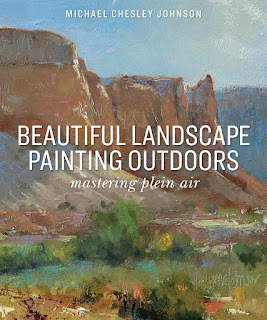 |
| Whites by Gamblin Artists Colors |
(This is the final post in my series on color. Next, I'll start a series on giving plein air paintings extreme makeovers!)
Not all whites are created equal. Most of us start painting with something like Titanium White and think that's all there is. But there's also Zinc White, Flake White and various versions of these. Gamblin's Titanium-Zinc White remains my go-to choice for a mixing white because it's dense and opaque like Titanium White but has the creaminess of Zinc White.
HISTORY
Like black, white was one of the earliest colors. In the Lascaux drawings, calcite or chalk was used as a kind of "ground" on the cave walls so the bulls, painted with charcoal and red and yellow earths, would stand out. Around the 4th century B.C., the ancient Greeks invented a process for creating Flake White (or Lead White). The unpleasant process involved exposing scraps of lead to either vinegar or urine and heating them with dung; today we have a similar process that doesn't use body waste, but the resulting pigment is no less toxic. Even though it is very hazardous—Raphael died of lead poisoning at 37—Flake White was "the" white for centuries. Painters liked it because it was fast-drying and created a durable, flexible film.
In 1782, Zinc White was invented as a safe replacement. But though it doesn't discolor like Flake White when exposed to sulfur compounds—Ultramarine Blue contains sulfur—it does darken over time in linseed oil and creates a brittle film. On the plus side, it is more transparent than Flake White and colors mixed into it retain more of their intensity. Finally, in 1921, Titanium Zinc was created. This brilliant, opaque white makes a more flexible film and doesn't discolor. It's a cold white, though, and colors mixed into it lose warmth and intensity quickly.
Gamblin's Titanium-Zinc White takes the best of both whites as I noted earlier. They also make a Warm White, which is the same mixed white with a little yellow and orange added. Finally, Gamblin offers a Flake White Replacement, which has the best properties of traditional Flake White: It's creamy, warm and translucent—but without the toxicity of lead.
USAGE
No matter what white you use, white can cause your colors to turn chalky and cold. (My late mentor, Ann Templeton, called white the "color killer.") I try to use it sparingly, preferring to use lighter pigments rather than add too much white. Another option is Gamblin's Radiant Colors series, which consists of tints of the major color families that have been tweaked to maintain intensity.
Pure white makes a hard note on your canvas. If I need to make a highlight, I'll take white and tint it to get the appropriate temperature rather than use pure white. Tinting the white also slightly lowers the value so the highlight doesn't jump out as much. If I want this highlight to appear lighter, I'll darken the area around it rather than go with pure white.
Finally, can you get your whites whiter than white? Yes! Adding a pinhead's worth of Cadmium Yellow Light to the white warms it up slightly, actually making it seem whiter.
I'm sorry that this time around I don't have swatches. You can learn more about Gamblin's whites here: https://gamblincolors.com/getting-the-white-right-by-robert-gamblin/
You can learn more about Gamblin's line of colors here. They also have a series of informative articles about the color experience here.









































